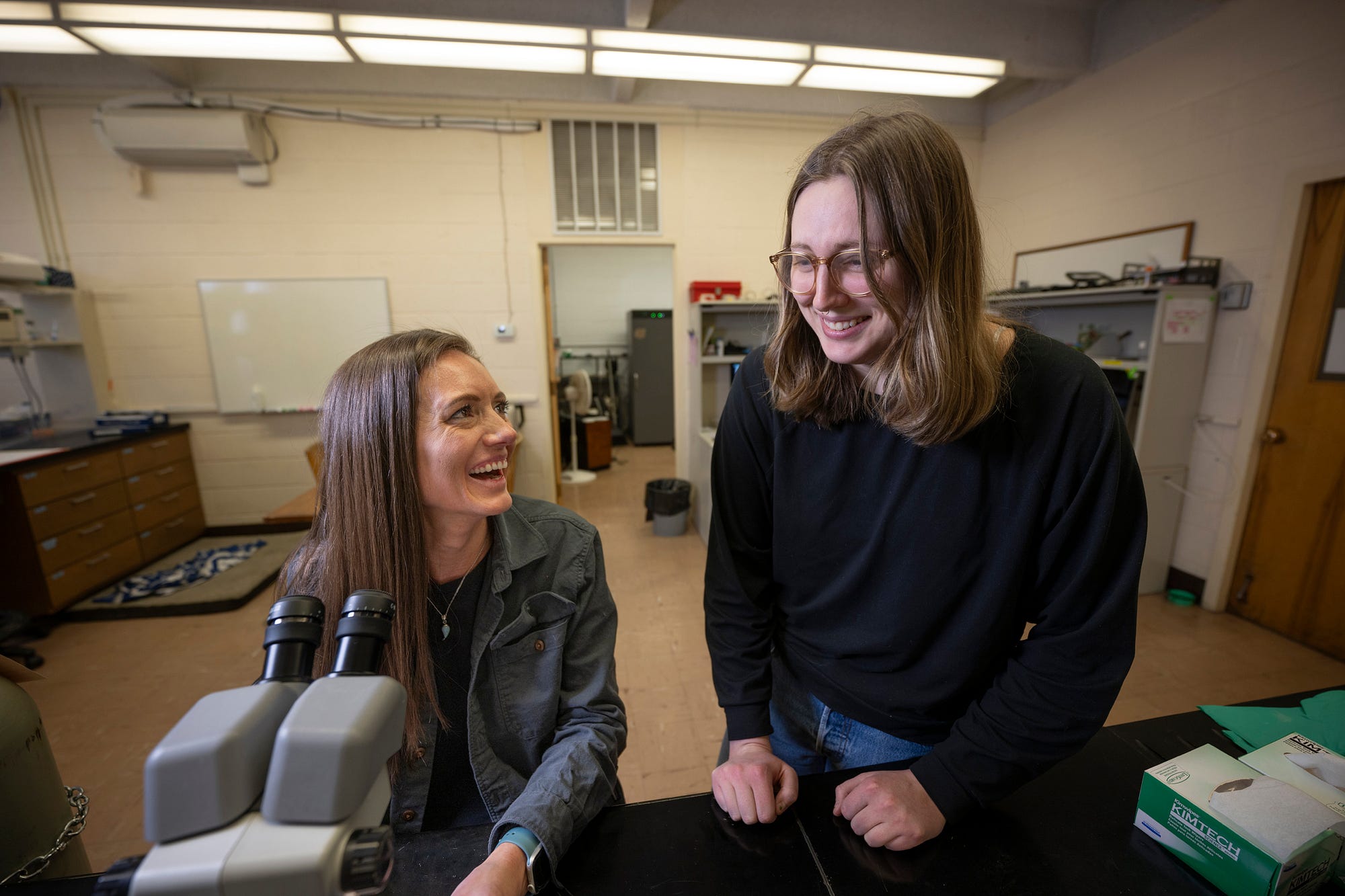Hangry Fruit Flies Advance Soldier Science

For years, Snickers candy bar commercials reminded us that, “You are not you when you’re hungry.” While hunger will not literally morph us into Betty White playing football or tough-guy actor Danny Trejo starring in suburban family sitcoms, there is ample evidence that our guts — including the mix of bacteria in our guts — play a significant role in governing other aspects of health, including our emotional state.
Sarah Certel, a UM associate professor of neuroscience, studies how behaviors are hardwired into the nervous system yet influenced and changed by internal and external environments. Certel’s research is part of a broader movement to better understand this complex gut-brain relationship, one that piques the interest of food bloggers and military leadership alike.
“There has been a recognition among microbiologists, neurologists and even diet scientists that these systems in our bodies are more interconnected than previously thought,” she says. “An increasing number of studies are looking at how this complex, interconnected system impacts our physical and emotional well-being, as well as our behavior. This information in turn has spurred on a larger community of people to realize that they can be more proactive with their health.”
While this topic has resulted in a broader societal understanding of and appreciation for probiotic food options and the value of eating raw produce over heavily processed foods, it also has opened new research avenues for understanding how the gut and brain communicate when you are hungry or when you are stressed and how your behavior is subsequently affected.
The Certel lab focuses on aggression, and in November 2023 the team received a grant from the U.S. Army Research Office for more than $1 million to study how gut-brain signaling impacts aggressive behavior and whether it affects males and females differently. The military has a strategic interest in understanding how an ingested pathogen could influence gut-brain signaling and subsequently alter male and female warfighter behavior.
Research has shown there are some key differences between male and female gastrointestinal systems, including length and the mix and makeup of gut bacteria and gene expression, the process by which genes transmit chemical instructions.
An overall goal of the U.S. government is to improve soldier protection against bioweapons. Certel says biological threats are a serious national security challenge facing the United States and the international community. One consideration is biological threats that target the intestinal system to ultimately drive changes in behavior.
Filling her lab full of male and female volunteers who have not eaten for hours or eaten harmful bacteria would neither be pleasant nor give much insight into identifying critical gut-brain signaling factors that impact aggressive behavior. So the researchers focused instead on identifying these factors in the ordinary fruit fly, Drosophila melanogaster. These common insects have long served as early test cases in biological research, as they not only reproduce rapidly but also share many key physiological properties as humans — namely that their gastrointestinal systems function similarly and share the same basic anatomical structures.

The Certel lab uses fruit flies in its work.
These flies also use similar cells to humans for processing food into energy for the body and share many of the same genes that tell cells what to do and when. This combination means that gut research on Drosophila can help inform and guide hypotheses related to the human gut-brain relationship.
The Certel team generated fruit fly lines with microbe-free guts and found that they were more aggressive. Certel noted that aggression is not inherently a bad thing — as long as it comes at the right place and at the right time.
“Aggression is a necessary behavior; all living things fight for access to resources, access to mates or access to territory,” she says. “If an organism ingests a very nutritious food source, the gut can tell the brain, ‘This resource has value, you should protect it.’”
The team next will introduce specific pathogenic bacteria into the flies’ diet and determine if male and female flies fight more or less often, and also identify the signaling factors that communicate these gut changes to the brain.
These expansive research goals are supported by an enthusiastic cohort of neuroscience undergraduate and graduate students.

UM undergraduate student researchers DeAnna Cuello (left) and Erin Szalda-Petree perform experiments in the Certel lab.
“It is critical to have such motivated and talented students, in addition to carrying out the experiments, they bring an amazing energy to the lab,” Certel says.
The team’s work is also made possible through the use of facilities provided by UM’s Center for Biomolecular Structure and Dynamics and its incredibly supportive grant staff. In addition, Dr. Steve Stowers at Montana State University has developed tagged versions of neurotransmitter receptors using genome editing to allow the visualization of these receptors in specific intestinal cells.
Supported by the strong research environment at UM, Certel hopes their research can one day advance more personalized approaches to medicine and health care. Studies have shown, for instance, that those who suffer from gut dysfunction before a physical injury like a concussion are more likely to have a slower recovery with more complications. Gut dysfunction also may lead to changes in behavior.
“When a person walks into a physician’s office, I would like to know that our work helps doctors go from saying, ‘women are more likely to suffer from depression,’ to, ‘this is what we can do about it,’” she says. “A goal is to make the information we uncover applicable for protection against a bioweapon but also for proactively keeping people healthy and more effectively reacting in the case of disease.” •
